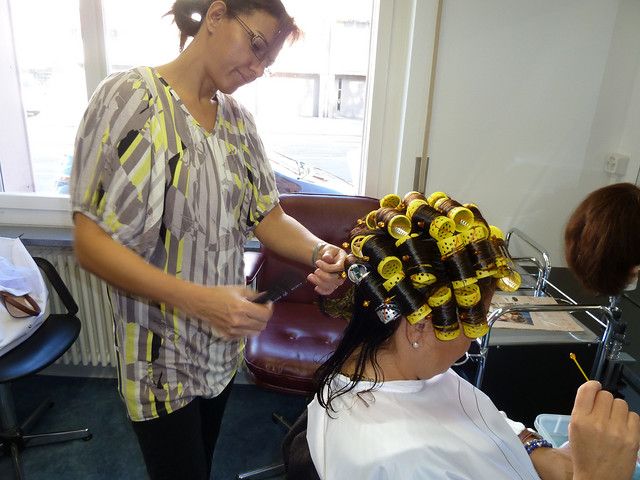The Future of Hairdressing

The world of hairdressing is continuously evolving, blending timeless artistry with the latest technological advancements. What was once an industry dominated by scissors, combs, and blow dryers is now embracing cutting-edge innovations that are reshaping the way hair professionals work and the experiences they offer clients. In this blog post, we will explore the future of hairdressing, focusing on emerging technologies, innovative trends, and the potential for growth in this vibrant industry.
Technology and Innovation in Hairdressing
Hairdressing, as a craft, has always required a combination of skill, creativity, and an understanding of clients’ needs. However, with the increasing integration of technology, the future of hairdressing looks set to become even more dynamic. From AI-driven styling advice to virtual consultations, here’s a look at some of the exciting innovations currently shaping the industry.
1. AI-Powered Styling Tools
Artificial intelligence is already making waves across various industries, and hairdressing is no exception. AI-powered styling tools can now recommend hairstyles based on a client’s face shape, hair type, and lifestyle preferences. Using facial recognition and machine learning, these systems analyze a person’s unique features to suggest the most flattering looks.
For instance, apps and devices that leverage AI can offer clients virtual try-ons of different hairstyles and colors before making a decision. This reduces the risk of regret and helps professionals better understand their clients’ preferences, ultimately enhancing customer satisfaction.
2. 3D-Printed Hair Accessories
While hairdressing traditionally involved physical tools like brushes, clips, and styling products, the rise of 3D printing has revolutionized the production of hair accessories. Stylists can now create custom-made hairpins, combs, and even entire wigs using 3D printers. This allows for incredible personalization, where accessories can be designed to suit an individual’s taste, hair texture, or the specific needs of a hairstyle. 3D printing also reduces waste and production costs, offering a more sustainable approach to hairdressing products.
3. Virtual Hair Consultations
In the digital age, convenience is key. Many salons are adopting virtual consultation platforms that allow clients to meet with their hairstylist remotely. These platforms utilize video calls and photo uploads to assess clients’ hair conditions, determine the best treatments, and discuss potential styles—all from the comfort of their homes.
This not only expands the potential reach of hairstylists to clients around the world, but it also allows for a more personalized and tailored service. Clients can get expert advice on color choices, hair care routines, and even salon treatments without having to step foot into a salon, which is particularly beneficial for busy individuals or those living in remote areas.
4. Smart Hair Tools
Hairdressing tools are becoming smarter, integrating technology to provide better results with less effort. For example, smart hair dryers and straighteners are now equipped with sensors that monitor the temperature and moisture levels of hair in real time, adjusting automatically to ensure optimal styling. This means less damage to the hair and more efficient styling. These tools also come with app connectivity, allowing users to control settings through their smartphones.
Similarly, the advent of smart curling irons that offer adjustable temperature settings based on hair type and a variety of curling styles is giving both stylists and clients greater control over the styling process. These innovations are making it easier to achieve salon-quality results at home, and for professionals, they enhance the quality of the services they offer.
5. Hair Dyeing Technology
Coloring hair has always been a delicate process, requiring expertise to avoid damage and ensure even, vibrant results. Innovations in hair dyeing technology are paving the way for faster and more precise applications. For instance, some color application tools now come with automatic precision dispensers that ensure the right amount of dye is applied to each strand.
Furthermore, new advancements in semi-permanent and non-toxic hair color formulas are providing longer-lasting results with less damage. In addition, customizable hair color options powered by AI allow clients to experiment with various shades before committing to a new look.

Trends Shaping the Future of Hairdressing
In addition to the technological innovations transforming the industry, several key trends are driving the evolution of hairdressing. These trends reflect changing consumer preferences, environmental concerns, and shifting cultural dynamics.
1. Sustainability and Eco-Friendly Practices
As sustainability becomes a priority across industries, hairdressing is following suit with more eco-conscious practices. From biodegradable packaging for hair products to waterless hair treatments, salons are becoming increasingly mindful of their environmental impact.
Hair professionals are also adopting eco-friendly hair care products, such as organic shampoos, conditioners, and color treatments that are free of harmful chemicals. These sustainable options are appealing to environmentally-conscious clients who want to maintain their beauty routine without harming the planet.
Moreover, many salons are implementing recycling programs for hair products and tools. For example, salons can now recycle hair clippings, which are being repurposed for oil spill cleanups or used in various composting programs. By incorporating sustainable practices, the hairdressing industry is not only catering to consumer demand for eco-friendly solutions but also setting an example for other industries.
2. Personalization and Customization
Gone are the days when one-size-fits-all beauty treatments dominated the salon space. In the future, personalization and customization will be at the forefront of hairdressing. From custom haircuts and colors to tailored hair care regimens, clients are seeking highly individualized services.
With advancements in technology, stylists can now create bespoke treatments based on a client’s hair type, scalp condition, and personal preferences. Data-driven solutions like DNA tests and scalp analysis devices are helping stylists to fine-tune their recommendations and treatments, ensuring clients receive the best results.
Clients will also have the ability to track their hair care progress through apps that monitor hair growth, damage, and treatment efficacy over time. These apps may even offer alerts when it’s time for a trim or a touch-up, further enhancing the personalized experience.
3. Inclusivity and Diversity
The future of hairdressing will be one of inclusivity, embracing all hair textures, types, and styles. As the beauty industry becomes more diverse, the demand for hairstylists who are trained in working with a wide range of hair types is increasing.
Stylist education is adapting to meet this need, with an emphasis on understanding the unique requirements of curly, coily, and textured hair. Additionally, the rise of gender-neutral styling and the celebration of natural hair textures is creating space for everyone to feel seen and represented in salons.
4. At-Home Hairdressing
The rise of DIY beauty trends and an increase in people working from home have made at-home hairdressing a major trend. With high-quality tools and products becoming more accessible, clients are taking their hair care into their own hands, from basic trims to more advanced styles like balayage and highlights.
Salons are responding to this trend by offering virtual tutorials, live consultations, and even mobile services that bring the salon experience directly to clients’ doors. These on-demand services make it easy for clients to get salon-quality treatments at home without sacrificing convenience.
The Future of Hairdressing is Bright
The future of hairdressing holds exciting possibilities, driven by technology, personalization, and a commitment to sustainability and inclusivity. As innovations continue to transform the industry, both professionals and clients will benefit from more efficient, customized, and eco-conscious services.
For hairstylists, staying informed about these changes and embracing new technologies will be essential to staying competitive and offering the best possible service. Beauty Cuts Hairdressers Poole is a great example of a salon embracing these trends, ensuring that sustainability and innovation are at the heart of their service offerings. As we look ahead, it’s clear that hairdressing will continue to be an art form—one that blends creativity with cutting-edge innovation, creating endless opportunities for growth and change.







